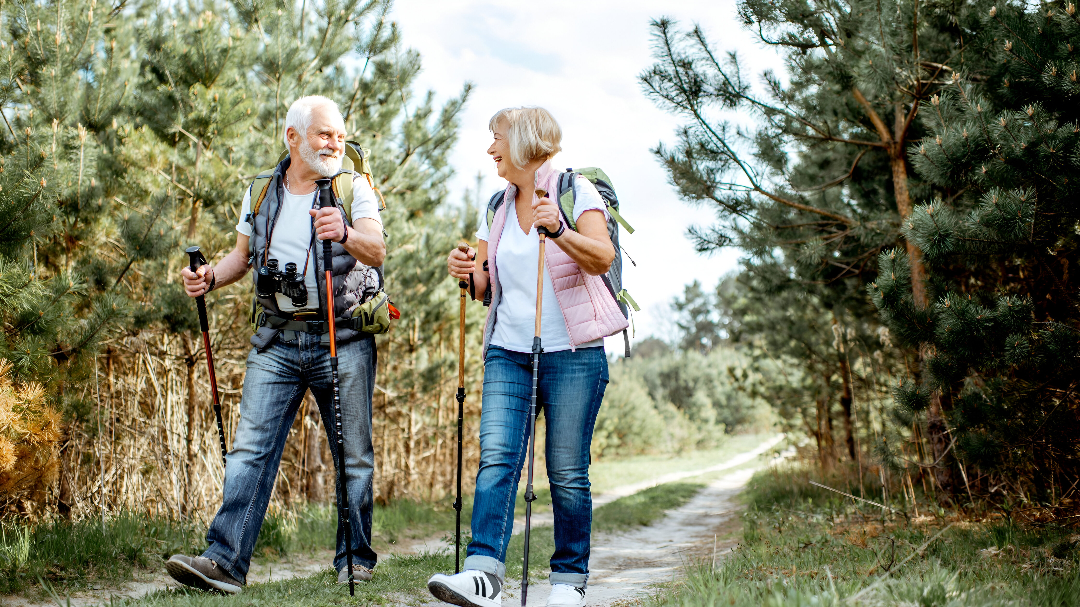Staying active after 50 is one of the best strategies to maintain strength, mobility, and overall health. But for many older adults, the difficulty is finding a form of exercise that’s both safe and enjoyable. Hiking for seniors is one of the best solutions, blending gentle physical activity with the mental benefits of being in nature. Unlike high-impact workouts such as running or jumping aerobics, hiking is a low-stress, joint-friendly activity that can be readily tailored to your fitness level.
In this blog, we’ll cover the best hikes for seniors, how to choose low-impact trails 50+, and the unique hiking benefits for older adults. You’ll also learn how to organize joint-friendly walking exercises and ways to enjoy safe hiking with knee pain.
👉 Explore more senior wellness guides at YFitnessMatters.
1. Why Hiking Is Ideal for Seniors Over 50
Our joints naturally lose flexibility as we age, muscles weaken, and recovery times become longer. That doesn’t mean activity should quit—in fact, movement is precisely what keeps the body strong. Hiking after 50 is a weight-bearing exercise, which helps preserve bone density, while its slower pace makes it more comfortable for people with joint sensitivity.
Key hiking benefits for senior citizens include:
- Cardiovascular health – Regular hiking strengthens the heart and improves circulation.
- Bone support – Walking against gravity reduces the risk of osteoporosis.
- Balance and stability – Handling uneven trails trains stabilizer muscles and coordination.
- Mental health – Time in nature lowers stress and improves memory.
Even just two or three hikes per week can greatly increase energy levels, sense of independence, and long-term health for those over 50.
2. Best Hikes for Seniors: What to Look For
Not all trails are built for senior fitness. Choosing the right environment is essential to avoid strain while still reaping benefits.
When looking for the best hikes for seniors, consider:
- Flat or gradual inclines – Avoid trails that are too steep or rocky.
- Surface type – Dirt and gravel paths are kinder on the joints than concrete.
- Short loop options – This allows freedom to pause when needed.
- Amenities – Trails with seats, water access, and shade are best for longer walks.
By prioritizing low-impact trails 50+, you can keep hiking enjoyable and sustainable for years to come.
3. Joint-Friendly Walking Workouts on Trails
It’s not necessary for a hiking routine to be long or exhausting. Many seniors benefit from shorter, consistent joint-friendly walking workouts on local nature paths.
Tips to maximize your hikes:
- Warm up for 5 minutes with gentle stretches before getting started.
- Use trekking poles to reduce pressure on knees and enhance posture.
- Walk at a steady pace where you can still have a conversation.
- Add variety by mixing brief bursts of intervals with slower walking.
- End with a cool-down and light stretching for the legs and lower back.
This approach transforms hiking into a complete workout that improves stamina, supports joints, and enhances flexibility.
👉 See our guide to safe and effective exercise.
4. Safe Hiking for Knee Pain
Knee pain is one of the most common reasons older adults avoid hiking. But with careful planning, it’s still possible to enjoy the outdoors without aggravating pain.
Strategies for safe hiking with knee pain include:
- Choose softer terrain – Dirt paths are better for cushioning joints than hard surfaces.
- Take small steps on descents – This lowers the pressure on the knees.
- Supportive shoes – Look for padded soles and ankle stability.
- Start small – Begin with 20–30 minutes of hiking and increase gradually.
- Strengthen leg muscles – Strong quads and hamstrings provide better knee support.
With these techniques, hiking becomes safe and accessible even for people with arthritis or past joint problems.
5. Hiking Benefits for Older Adults Beyond Fitness
While physical fitness is a big plus, the mental and emotional benefits of hiking are equally valuable.
- Boosts mood – Sunlight and fresh air naturally raise serotonin levels.
- Sharpens focus – Exposure to natural environments enhances memory and cognition.
- Encourages social connection – Group hikes lower feelings of loneliness.
- Provides stress relief – Hiking lowers cortisol levels, promoting relaxation and better sleep quality.
In short, hiking nourishes both body and mind, making it one of the most comprehensive wellness activities available to seniors.
6. How to Start Hiking Safely After 50
If you’re new to hiking, the key is to start slow and be well-prepared. Here’s a step-by-step approach:
- Consult your doctor before beginning, especially if you already have joint issues.
- Begin with short hikes on flat trails—15–20 minutes is enough at first.
- Wear proper gear, including supportive shoes and breathable clothing.
- Stay hydrated and bring water, especially on hotter days.
- Gradually increase distance as your stamina builds.
These precautions ensure the transition is smooth and lower your risk of injury.
Conclusion
Hiking for seniors over 50 is one of the most fulfilling, joint-friendly exercises available. With low-impact trails 50+ and proper preparation, it provides a safe way to improve heart health, support bones, lower stress, and maintain social connections. Whether you wish for a light joint-friendly walking workout or to explore longer scenic paths, the secret is consistency. If you do it properly, hiking can help you stay active, independent, and healthy well into your later years.
👉 Start your journey today with senior-friendly fitness and wellness guides.
